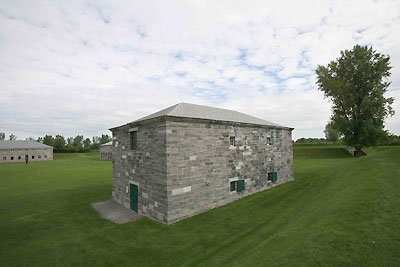
Historic Site management
Fort Lennox National Historic Site
Management of a National Historic Site is directed by imperative presented in the Commemorative Integrity Statement and on the objectives and themes described in the management plan itself. Here is some information from Fort Lennox Commemorative Integrity Statement and management plan.

Rear view of the ordnance magazine.
© Parks Canada / Benoît Aquin
The commemorative integrity statement
According to the National Historic Site Policy, the Commemorative Integrity Statement identifies the National Historic Site cultural resources and objectives to ensure that they are not impaired or under threat, interpretive messages and learning objectives. At the core of the management plan are strategies and actions to ensure that these resources are protected and the public understands the reasons of the site significance. The Commemorative Integrity Statement forms the primary accountability for evaluating how well the National Historic Site is being managed.
The objectives of commemoration are an important part of the commemorative integrity statement. Here are Fort Lennox objectives of commemoration according to the Commemorative Integrity Statement document (Parks Canada, 2002):
“Ile aux Noix (Fort Lennox) received the National Historic Site designation in 1920. The purpose of this designation, already presented in the Commission verbal-brief of May 1920 and in the texts of the commemorative plaque installed on the island in 1923 and 1982, is:
Ile aux Noix has been fortified many time since 1759 and a garrison occupied it until 1870 to prevent invasion from the Richelieu river, one of the entrance road to Canada.”
Management plan
The purpose of a management plan is to provide guidelines, for both the short and the long terms, for the conservation use, development and management of the resources of a National Historic Site.
Fort Lennox management plan was presented to public in Fall 1991. Among other things, it gives the site's important themes and the objectives. This plan in now under revision.
Themes and objectives
(extract from the Fort Lennox National Historic Site Management Plan, Environment Canada, Parks services, 1993)
The development of Fort Lennox National Historic Site must be in keeping with approved themes and objectives. Defining the themes and objectives of a site, in fact, the first step in the planning process and is intended to serve as a basis for the site's development.
At Fort Lennox, five themes have been identified, with emphasis being placed on British occupation of the island:
- Ile aux Noix: two Centuries of Military and Civilian Occupation
- From a French entrenchment to a British border post:
- The Richelieu: an invasion route*
- The siege of 1760 and the first entrenchments*
- The fortifications of 1782 and the war of 1812
- The construction of Fort Lennox (1819)
- From the departure of British troops to today:
- The decline of military functions
- New activities*
- The intervention of the Canadian Parks Service*
- From a French entrenchment to a British border post:
- Fort Lennox: Military Camp for 19th-Century Garrisons
- Organization and operation of the post
- Military and paramilitary activities
- Living conditions in the garrison
- Fort Lennox: A Feat of British Military engineering
- Regional conditions
- Previous forts
- Classic fortification:
- Flanking geometry
- Depth development
- Strength of materials
- Armament
- The buildings;
- Neoclassical style
- Functional architecture
- Shipbuilding
- Techniques and materials
- Ships: types and design, value and use
- The shipbuilders
- Nature and Civilization on île aux Noix
- Changes to landscape for military and other purposes
- The current environment (flora and fauna)
Resource preservation and development objectives are as follows:
- To ensure the preservation of île aux Noix's historic resources for present and future generation;
- To develop the historical themes for visitors by means of interpretation and various publications;
- To protect as much as possible the park's natural environment and the surrounding waters, while stressing the presence of historical resources;
- To favour discovery of the park's resources by providing visitors with appropriate services;
- To contribute to the enhancement of the Upper Richelieu's heritage and participate in the growth of cultural tourism in the Great Montreal area.
- Date modified :